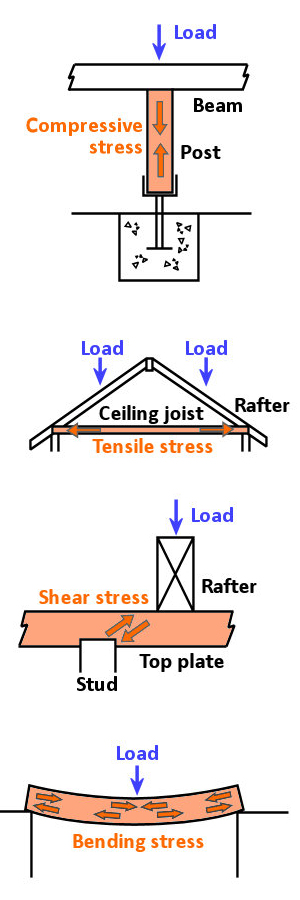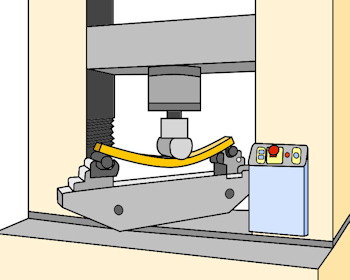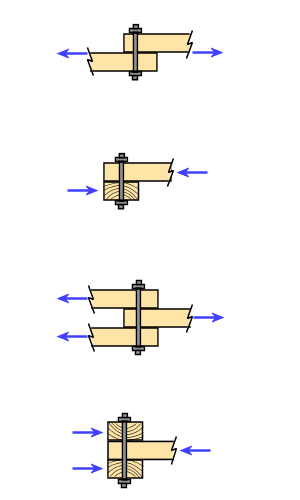Strength

stresses found in building structures
Strength in timber is its ability to withstand a force without failing or permanently deforming.
When timber is used in a structure, it needs have reliable strength properties so that the overall design is able to accommodate the individual stress limitations of each structural member.
Types of stresses
There are four basic types of stresses that structural members may be subjected to: compressive, tensile, shear and bending.
Compression refers to a load that tends to shorten or crush a member. For example, a post that supports a beam is subjected to compressive stresses.
Tension refers to a load that tends to stretch a member. This occurs in components that need to resist a pulling-apart action, such as a ceiling joist fixed to the foot of two rafters, which resists their tendency to spread apart under the roof load.
Shear refers to a load that tends to slide one part of a member over an adjacent part. This can occur in places where a defect in the timber component might weaken the wood fibres and cause them to split along the grain, such as in the top plate of a wall frame.
Bending refers to a load that tends to bend a member along its length, such as in a beam supported at both ends. Bending strength is the ability to resist this type of stress, and the basis of structural grading principles.
We’ll talk more about structural grading in Section 5. However, for now it’s worth noting that the bending strength of a piece of timber is also related to its strength in compression, tension and shear.
This is because when a timber component is subjected with bending stresses:
-
the top part tends to shorten, producing compressive stresses
-
the bottom part tends to lengthen, producing tensile stresses
-
the interaction of compressive and tensile stresses produce shear, as the different layers try to slide over each other.
Note that bending strength is always measured along the length of the timber – that is, with the grain rather than across the grain. Timber is 20 to 30 times stronger parallel to the wood fibres than it is perpendicular (at right angles) to them, depending on the species, since most of the strength is in the cellulose fibres themselves, not in the lignin that bonds the fibres together (see Section 1 for more details on the cellular structure of wood).
Strength groups

to determine the strength group of the species
See F grading with a machine for more details
on the relationship between bending strength
and Modulus of Rupture (MOR)
Timber species graded for structural purposes are classified into strength groups. There are various Australian Standards that show tables of strength groups, in particular: AS/NZS 2878 Timber—Classification into strength groups plus the various structural grading standards.
In most cases, the strength group of a species is determined by testing small clear samples under laboratory conditions, using pieces that are 20 x 20 mm in size and free from strength-reducing defects. In other cases, the strength group is arrived at by comparing the dry density of the species (density at 12 % moisture content) to similar species already classified.
Most timber species become stronger when they’re seasoned, since the fibres shrink and become stiffer and the lignin tends to harden. For this reason, there are two sets of strength groups:
-
one for green timbers, ranging from S1 (strongest) to S7 (weakest)
-
one for dry timbers, ranging from SD1 (‘S’ for strength, ‘D’ for dry) to SD8.
Below is a table showing some common examples of timber species and their strength group classifications. These figures are taken from the Wood Solutions website.
| Examples of strength groups for common timber species | ||||
| Timber species | Green density (kg/m3) |
Dry density (kg/m3) |
Strength (green) |
Strength (dry) |
| Grey ironbark | 1170 | 1106 | S1 | SD1 |
| Blackbutt | 1100 | 900 | S2 | SD2 |
| Sydney Blue Gum | 1110 | 840 | S3 | SD3 |
| Jarrah | 1100 | 820 | S4 | SD4 |
| Douglas fir (oregon) | 700 | 550 | S5 | SD5 |
| Radiata pine | 800 | 550 | S6 | SD6 |
| Light red meranti | - | 400 | S6 | SD7 |
| Western red cedar | 490 | 350 | S7 | SD8 |
Joint strength
Timber species used for structural purposes are also rated in terms of their joint strength. There are six joint groups for unseasoned timber, ranging from J1 (strongest) to J6 (weakest) and six for seasoned timber, ranging from JD1 to JD6.
Joint groups are roughly correlated with strength groups, since they are both related to timber density.

(shown by the blue arrows)
to test the joint strength
of different timber species
However, the joint group ratings for a particular species are often one or two numbers higher than strength groups for the same species, given the fact that there are eight strength groups for seasoned timber and only six joint groups. For example, radiata pine is classified as S6 and SD6 in strength, but its joint groups are J4 and JD4.
Most reference tables that list the mechanical properties of individual species will show the joint groups for the species.